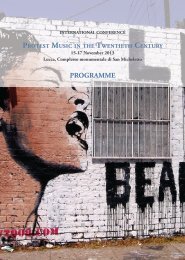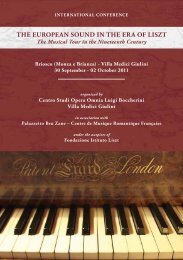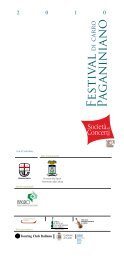Programma - Provincia di Lucca
Programma - Provincia di Lucca
Programma - Provincia di Lucca
Create successful ePaper yourself
Turn your PDF publications into a flip-book with our unique Google optimized e-Paper software.
sull’autorevolezza delle loro e<strong>di</strong>zioni boccheriniane e sul significato delle varianti in esse contenute.In effetti, lo stemma co<strong>di</strong>cum e la vicinanza cronologica tra l’e<strong>di</strong>tio princeps e le successive e<strong>di</strong>zionidell’Op. 15 in<strong>di</strong>cano chiaramente che queste ultime non furono semplici ristampe, ma che venneropubblicate col benestare dello stesso Boccherini e stampate a partire da materiale <strong>di</strong> prima mano. Lemacrovarianti delle e<strong>di</strong>zioni <strong>di</strong> Marescalchi e <strong>di</strong> Hummel potrebbero quin<strong>di</strong> essere dei ripensamentiche il compositore integrò nei quartetti prima <strong>di</strong> inviarli ai due e<strong>di</strong>tori. Se ciò fosse vero, le stampe<strong>di</strong> Marescalchi e <strong>di</strong> Hummel <strong>di</strong> altre opere <strong>di</strong> Boccherini potrebbero ora rivelarsi fondamentalitestimoni <strong>di</strong> eventuali revisioni d’autore.• Thomas M. Cimarusti (Texas Tech University):‘Good Old’ Boccherini: The Reception of Luigi Boccherini’s Chamber Music in Nineteenth-Century AmericaBy 1765, five years following his appointment as cellist in the Cappella Palatina of <strong>Lucca</strong>, theTuscan-born Luigi Boccherini had already established a fine reputation as a composer of chambermusic. Engagements in Vienna, <strong>Lucca</strong>, Pavia, Cremona Genoa, and London clearly in<strong>di</strong>cate amost active schedule, one which often brought into contact with such <strong>di</strong>gnitaries as Leopold i,the Grand Duke of Tuscany, King Friedrich Wilhelm ii of Prussia, King Carlos iii, and manyothers. In spite of his success, however, some scholars claim that the performance of Boccherini’smusic has often been neglected following the composer’s death in 1805. An examination ofearly nineteenth-century American perio<strong>di</strong>cals appear to tell a <strong>di</strong>fferent story. Although theperformance of Boccherini’s music may in fact have been eclipsed by compositions by other moreacclaimed European composers in the American nineteenth-century concert hall (e.g., Mozartand Haydn), numerous American perio<strong>di</strong>cals, inclu<strong>di</strong>ng Dwight’s Journal, The Message Bird, TheBoston Musical Gazette, and The Visitor make reference to a host of successful performancesof Boccherini’s music. In one concert review, one anonymous author refers to the composeras «Good Old Boccherini» — undoubtedly a phrase in<strong>di</strong>cating the composer’s familiarity andpopularity to a rather nascent American musical culture. The purpose of this paper then is totrace the reception history of Boccherini’s chamber music in nineteenth-century America viamusic perio<strong>di</strong>cals and journals. Such a study, however, not only aids our understan<strong>di</strong>ng of thereception of Boccherini’s music in America, but may also illuminate the role Boccherini’s musicmay have played in shaping nineteenth-century American culture.• Barbara Cipollone (Università <strong>di</strong> Bologna):I Quartetti <strong>di</strong> Boccherini trascritti per due clavicembali e la prassi settecentesca <strong>di</strong> “accomodare”per le tastiereI sei Quartettini G. 195-200 <strong>di</strong> Luigi Boccherini, composti nel 1778, furono pubblicati a Viennanel 1781 come Op. 32. Considerati dall’autore «opera piccola» in quanto costituiti ciascuno <strong>di</strong>due soli movimenti, essi furono trascritti per due clavicembali da mano anonima alla fine delsecolo e si conservano manoscritti presso la Sächsische Landesbibliothek <strong>di</strong> Dresda assieme aun’altra trasposizione della stessa opera «pour le clavecin ou pianoforte, violon, viola et basseobligé». Tali trascrizioni risalgono con ogni probabilità al periodo <strong>di</strong> reggenza dell’Elettore <strong>di</strong>Sassonia Federico Augusto (1763-1805), il quale ne commissionò <strong>di</strong>verse altre, tutte conservatea Dresda. La prassi <strong>di</strong> trascrivere per due clavicembali opere nate con una <strong>di</strong>versa destinazionestrumentale risale a oltre un cinquantennio prima, quando François Couperin ne legittimòl’applicazione al Trio noto come «Concert instrumental sous le titre d’Apothéose composé àla memoire […] de Lully» (1725), caldeggiando l’esecuzione de «la parte superiore e quella









